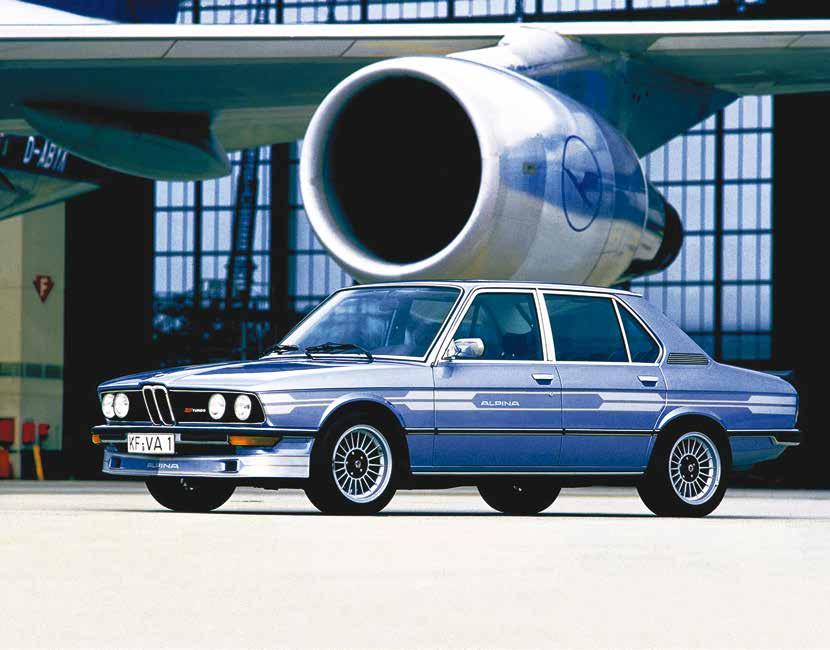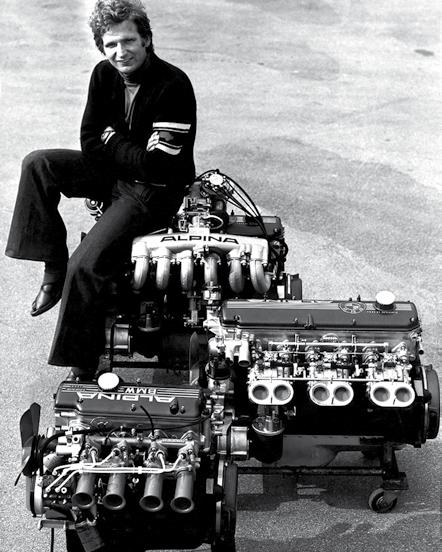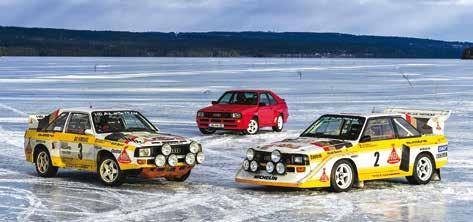
14 minute read
The Professor
The turbocharged engine in Alpina’s E12 B7 turbo was a milestone in German engine history. Newly appointed as Alpina’s Head of Engine Development, Fritz Indra took the BMW M30 3.0-litre straight six petrol engine and extracted more power by adding, amongst other additions, a KKK turbocharger which made the Alpina E12 B7 turbo the fastest 4-door saloon car in the world when launched at the 1978 Frankfurt IAA Motor Show…
Words: Alpina/Jeff Heywood. Photographs: Alpina Archive/Jeff Heywood.
Advertisement
Professor Indra, let’s start with your career at Alpina: In 1971, you decided to leave the bright lights of Vienna for the tranquillity of Buchloe in south-west Bavaria. You were working as a university assistant at the Vienna University of Technology, yet joined Alpina as the Head of Development. How did that come about? “First of all, I knew very early on that I wanted to be an engineer. While I was still in primary school, at the age of 10, I laid out my career plans in minute detail in an essay. Incidentally, I misspelled the word “doctorate” so badly that you couldn’t even see it for red pen. But that’s exactly what happened: after graduating as an engineer, I had the good fortune to be accepted as a university assistant in Vienna, where I was able to do my doctorate. There was nothing happening in Austria back then. There was no BMW plant in Steyr yet or anywhere else for wholehearted petrol engineers like me.
To keep my head above water as a university assistant, I had four or five part-time jobs. One of these was writing articles for the Austrian car magazine Autorevue. In 1971, they asked me to write an article about a certain Burkard Bovensiepen. So I travelled to Germany for an appointment, and Gert Hack was also there. At that time, he was on the executive board of Alpina and of course he’ll be well known to many as a journalist for Auto Motor und
Indra (R), pictured with Alpina founder and boss Burkard Bovensiepen. Bovensiepen had a reputation for being a hard taskmaster but Indra had a good relationship with him and enjoyed the freedom working as Head of Engine Development at a small company that was agile and could react quickly to market and legislation changes etc

Sport. And he was the one who asked me: “What do you actually do?” Well, I have a doctorate, I know a lot about exhaust gases and exhaust regulations – that’s what I did my doctorate on – for motorsports too – and I developed the Kaimann for Kurt Bergmann while I was studying. And just like that it became clear: this made me a perfect fit for Alpina. The deal was done so quickly that I started at Alpina as Head of Engine Development three months later! In Buchloe, a small village in the Allgäu. When I took my wife there for the first time, coming from Vienna, she sat down on the main thoroughfare of Buchloe and burst into tears.”

A milestone in your development work at Alpina was the M30 B7 turbo engine. So how did it come about that the first petrol engine with combined turbocharging was developed in Buchloe of all places? Fundamental research isn’t necessarily something you expect from a smallseries manufacturer. “It really came down to Burkard Bovensiepen’s vision for Alpina: he never wanted to be perceived as a tuning outfitter; he wanted to make Alpina a recognised automobile manufacturer, which he ultimately succeeded in. And of course you also have to back this claim up, you have to be innovative. Just making cars faster was never the be-all and end-all for Alpina. And simply adding more displacement to an Alpina engine to increase the power just wasn’t the right answer at the time. Because certain noise and emissions levels applied in the ‘70s too – it wouldn’t have worked anyway. And there was no easy way of squeezing more power from the BMW six-cylinder naturally aspirated engines of the time, which only had two valves per cylinder. It became clear to me then that turbo technology was the perfect answer: significantly increasing power while keeping displacement the same, in order to also meet all statutory requirements. However, turbochargers were still a
Professor Indra poses with some of the Alpina engines he helped to design or improve, including the Alpina B6 engine that he is perched on at the rear of the photo, which was based on the BMW M30B28.

novelty at the time. A few manufacturers had already made attempts at the technology, but those engines ended up being incredibly unresponsive, really fuel-hungry and on top of this kept breaking down. I thought to myself we could do better.
Then all the pieces started to fall into place. The successes we had enjoyed at the time in motorsports were of course a huge advantage. We had a very big network around us, with committed partners and suppliers who wanted to share Alpina’s success. Everything went hand in hand, and we were able to combine very different technologies: From the air intake resonance system designed by Dr. Gyula Cser to a fully electronic map ignition system – a completely new innovation at that time. The end result was a neat turbo engine suitable for everyday use that was first used in the BMW Alpina B7 turbo.”
Exactly what changes had to be made to the existing turbo petrol engines to make them – as you say – “suitable for everyday use”? “If you looked at the weak points of the turbo engines from that time, you would have seen how a number of modifications were needed. So the Alpina B7 engine used a variety of new technologies. For example the injection system: tests revealed how important precise fuel metering is in the turbo engine – not just for fuel consumption, but also for the responsiveness. The injection system therefore had to be able to register both the air density and the air volume, in order to be able to meter the fuel perfectly. Here
I insisted on the enhanced mechanical DL injection system from the company Pierburg. But the arrangement of the injection system was important too: locating it downstream of the compressor changed the pressure differential. The turbine speed decreased, which shortened the time required for turbine start-up and improved the responsiveness. Thermal stability was ensured by an intercooler. I employed an air-to-air system here. But the intake air temperature had to be right too and thus the arrangement of the intercooler, because this had a huge influence on power and fuel consumption. Our partner Kühnle, Kopp & Kausch (KKK) also developed a new turbine housing to our specifications for the K27 turbo. We needed to adapt the geometry because we could see that a smaller throat diameter would be beneficial in the low and medium rpm range in particular.
Another problem was that the turbo engines back then were very sensitive to knocking. The ignition timing was crucial here. However, you couldn’t control it precisely enough with the existing ignition systems. So we turned to the system from Dr. Hartig – a fully digital, computer-controlled map ignition system, an absolute innovation in automotive engineering. It made the tolerance band much narrower, and the ignition timings much more precise. This meant we had the knocking behaviour under control, but unfortunately the idling was still unstable. The fuel/air mixture just didn’t provide enough turbulence. So I started working with a pinch point in the combustion chamber. This resulted in more thorough mixing of the air and fuel, and the combustion in all six cylinders was more uniform as a result.
And then there was also the air intake resonance system by Dr. Cser, which I mentioned already. Alpina was the first to use this system on a petrol engine. In a six-cylinder engine, it divides the intake system into two groups of three cylinders each (see sketch images). The inlet ducts then each terminate in a separate resonator vessel, which is joined to the pressure side of the turbocharger via a resonance pipe. Simply put, this generates oscillations in the resonance volume, which changes the air density. This worked surprisingly well over a very wide rpm range, and fixed the problem of turbo lag. The performance curve was impressive – head and shoulders above the other turbo engines of the time.”

The fruits of your labour ended up with the B7 turbo being given the accolade the “fastest 4-door saloon car in the world”. A title that made everyone in the industry sit up and take notice. What was your perception of the response to the Alpina B7 turbo? “That’s correct, there was a huge response from the media to the B7 turbo. And an unbelievable number of comparison tests. The B7 turbo came out on top in all of them, even against
The 300bhp Alpina B7 turbo engine which powered the Alpina E12 B7 turbo.

The Alpina M30 turbo engine…
The E12 B7 turbo engine is based on BMW’s 3.0-litre ‘M30’ inline six; but not much is left of the standard engine. Alpina fitted a KKK (Kühnle, Kopp und Kausch) K27 blow-through turbo with a maximum boost of 12psi. But the boost was variable (by a dial in the interior) between 8psi and the maximum, which means, in terms of power, between 250bhp and 300bhp. An intercooler is also fitted, which was located behind the right hand pair of headlamps.
The turbo blew through race-style Pierberg/Zenith DL mechanical fuel injection, but while there was no ECU needed for the injection, there was with the ignition. In a world first for a road car, the B7 used Hartig adjustable electronic ignition, crucial for reliability. Because of the turbo’s variable output and the fierce underbonnet heat, the Hartig system would retard the ignition to curb detonation, potentially lethal to long turbo life. Lower compression forged pistons and new valves were also fitted, more suited to the turbo installation. To handle the greater power and 342lb/ft torque, Alpina fitted a specially modified 5-speed Getrag gearbox.
Indra may have been long gone, but his knowledge of turbocharging lived on at Alpina. Now a car manufacturer in their own right, the engine development team again turned to the M30 engine, taken from an E34 535i model. They dismantled the 3430cc M30 engine, replaced the stock pistons with forged Mahle units, installed two Garrett T25 water-cooled turbochargers, and added a Bosch variable boost control with a range of 0.4–0.8 bar, which was adjustable from the driver’s seat. This mighty twin-turbo unit, dubbed B7/5 in Alpina parlance produced 360bhp! When launched to the automotive world in 1989, the E34 B10 Bi-Turbo was again named the ‘fastest four-door saloon car in the world’, providing a nice link back to the E12 B7 turbo in 1978. The photo is magical, placing the B10 Bi-Turbo next to the fastest commercial airliner on the planet; but we must not forget Indra’s legacy and knowledge imparted on Alpina and their engine developers during his tenure in Buchloe, which allowed a car like the B10 Bi-Turbo to actually exist.

heavy hitters like the Porsche 911 turbo, the Jaguar XJ12 and so on. Although the B7 saloon turned out rather restrained – the handsome Bracq penned E12 was the perfect ‘understatement’ car. There were many ‘wolf in sheep’s clothing’ quotes although I prefer ‘a gangster in a businessman’s suit!’ But we had proof for once and for all of it being the fastest saloon of the time. Let me tell you, measuring the top speed was a real adventure back then. I was behind the wheel of the B7 turbo, with an official from the TÜV sitting beside me with a stopwatch. Back then, the measurement


was still done “in the wild” and not on a test track. We often used the east ring road around Munich for this, which wasn’t even finished at that point. Whenever we hit the 250km/h mark (155mph), a lorry would pull out in front of us which was a bit hairy! So it took a few tries until we reached our top speed.
And of course the ALPINA B7 turbo engine led to my reputation in the industry as the turbo expert from Buchloe. I published several articles about this engine. That’s how I came to the attention of a certain Ferdinand Piëch, who at that time was a division manager at Audi. He rang me and said: “I need a turbo man”. And that’s how I became the Head of Engine Development at Audi in 1979.”
Professor Indra went on to develop turbocharged 5-cylinder engines for Audi that would power the original UrQuattro and the successful World Rally Championship winning Quattros and the 200 turbo road and race cars.
Professor Indra was also asked his opinion on electrically powered cars, seeing as they are the main topic of conversation in the auto industry today;


The automotive sector is under pressure. Aside from all internal trouble a considerable part of the pressure in the industry is caused by legislation, Fritz Indra says. All car manufacturers are currently pushing electrification, which may also be a strategy to take the bull by the horns. But in the opinion of the Austrian engine designer and Formula 1 expert, the current trend towards the electric car should be regarded in a more critical way than it currently is the case. Especially with regard to climate protection, he says, because electric cars aren’t as clean as they are expected to be… Fritz Indra: “There’s controversy in the auto industry in the sense that I don’t get why the whole industry is developing so many electric vehicles now. VW is talking about a million in a few years. Yet they’re not selling at all, there are no customers today. Sales are dropping in America, falling fast in Norway and steady in Germany. All the subsidies aren’t helping. So why are all the companies developing such huge numbers of electric cars? Where are the customers supposed to come from? I don’t see why customers would buy something that’s worse than what they already have. And until electric cars have one or two big advantages over the cars they currently own, they won’t buy one. Also, 80% of cars are now bought by local authorities, not private customers. The police in Stuttgart, I believe, now have to drive electric cars to massage the statistics a bit” he added. “The German auto industry has adopted a proactive strategy for electric mobility so the government can’t accuse them of not really wanting to do anything. Daimler-Benz’s Franz Weber, for example, and other people in the industry are already saying it’s no good anyway, nobody will buy it, the range is too low, it’s too expensive, and when the battery pack gets old the car has no resale value. It’s unlikely that electric cars will ever really be better than the cars customers already have. Not in terms of costs, range or recycling. Nobody is talking about the fact that electric cars contribute nothing at all to climate protection. Not
when you add in ALL parameters and do the math correctly.”
Professor Indra isn’t a fan of electric cars, pointing out that when the battery pack gets old the car has no resale value, plus he argues that electric cars contribute nothing at all to climate protection when you add in all parameters.
When Indra moved to Alpina in 1971 they were a dynamic but quite small ‘tuner’, but his knowledge of turbocharging engines thrust both Alpina and himself into the spotlight of the automotive world when the B7 turbo was launched in 1978; it was quite obvious one of the larger manufacturers would come knocking and it was Audi supremo Ferdinand Piëch who eventually lured Indra away in 1979 by offering him the same position that he held at Alpina, Head of Engine Development. Indra developed the powerful 5-cylinder turbo engine for Audi that would power the Ur-Quattro to the World Rally Championship (for manufacturers) in 1982 and 1984. His turbocharged Audi engines would also power the 200 turbo to many race victories and championships as well as power many Audi road cars in the 1980s and 1990s.











